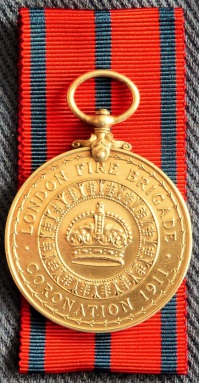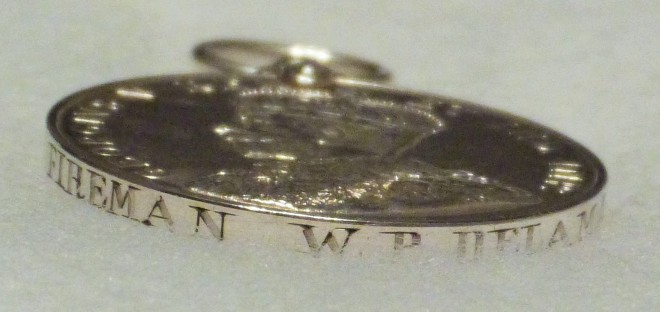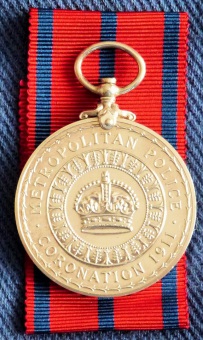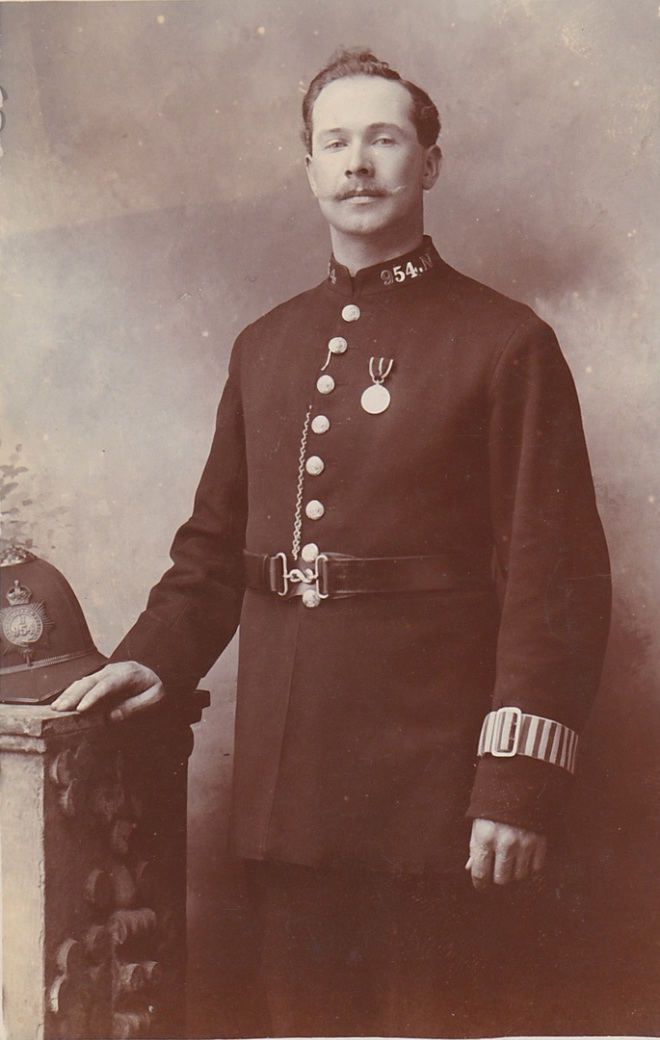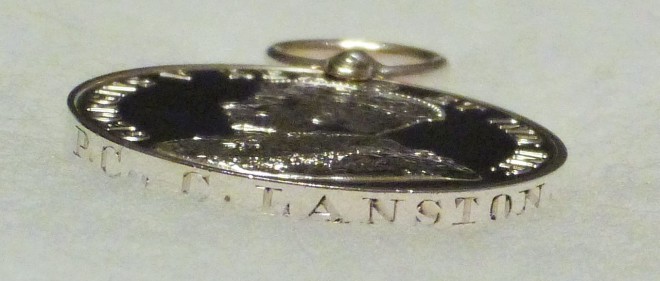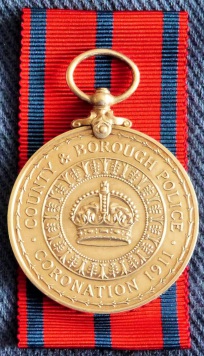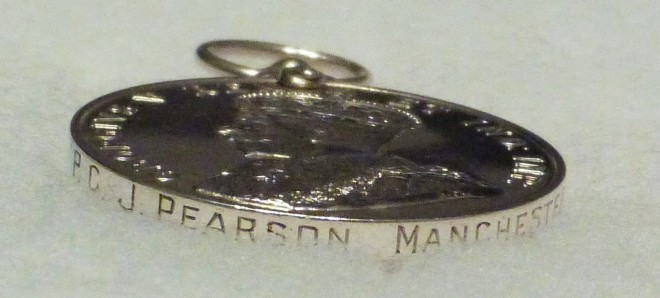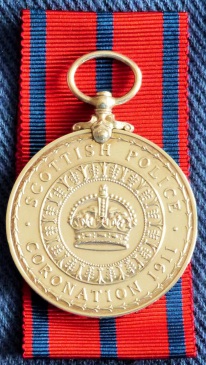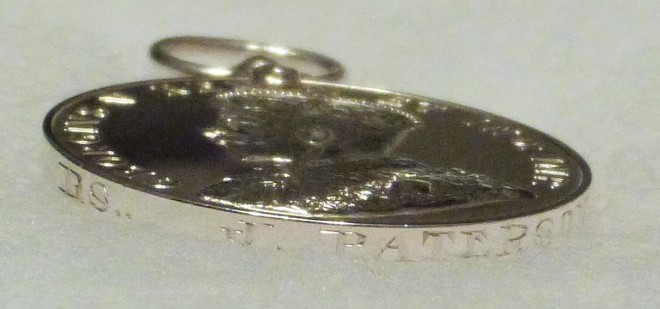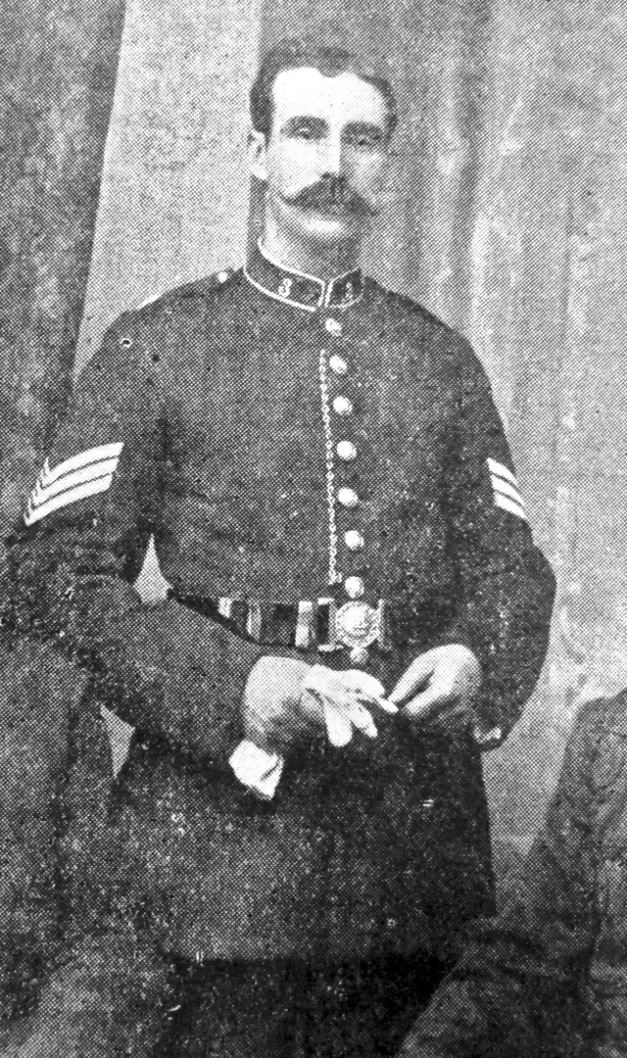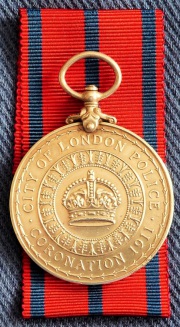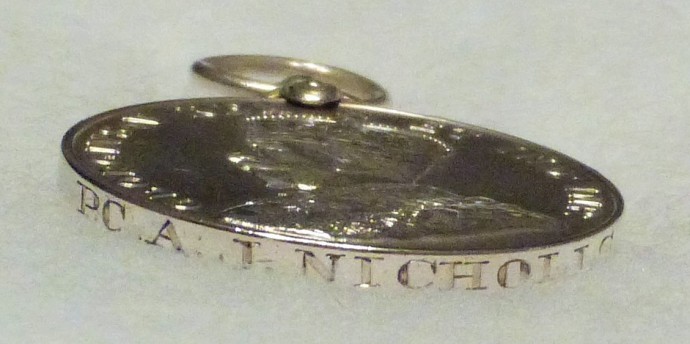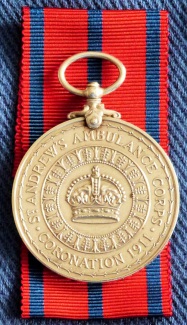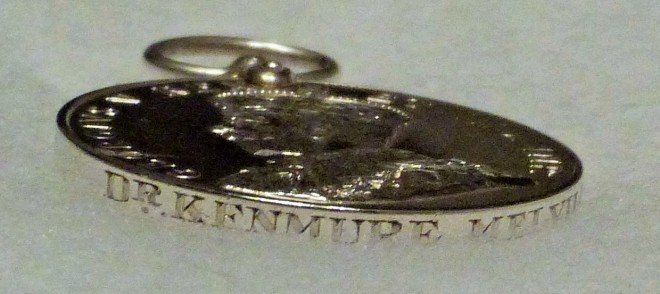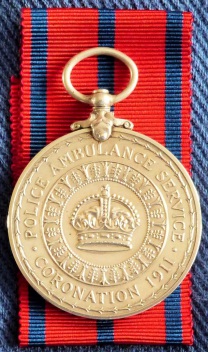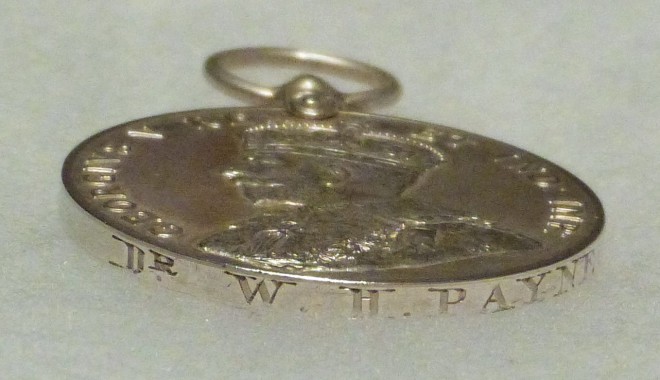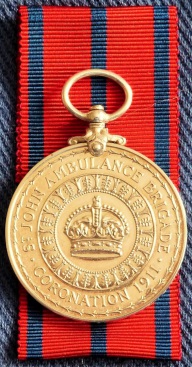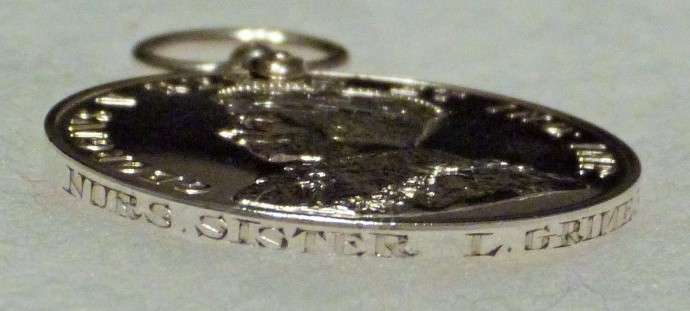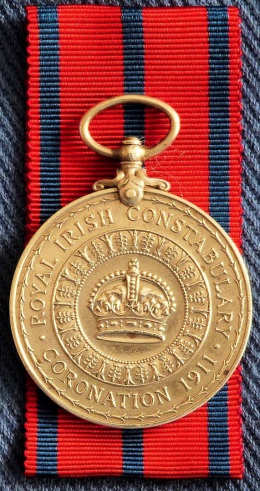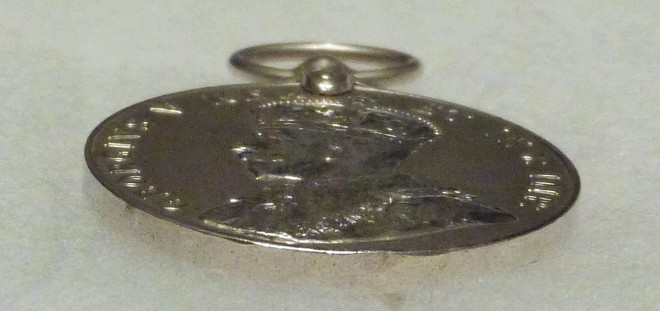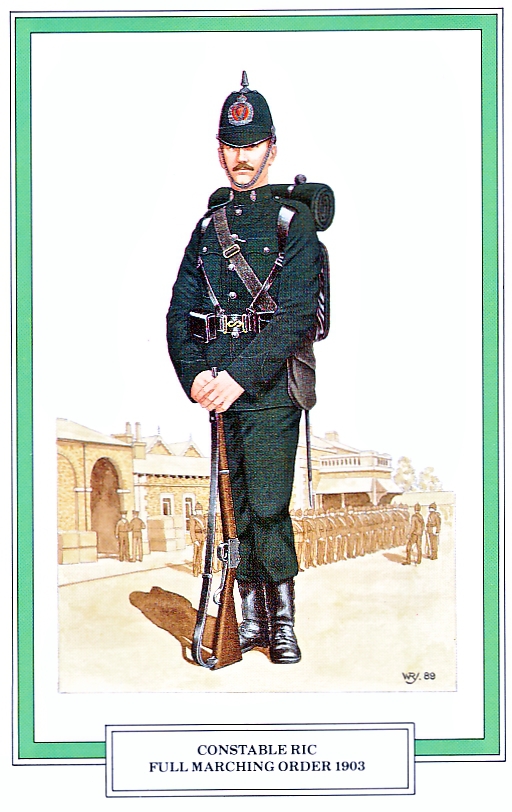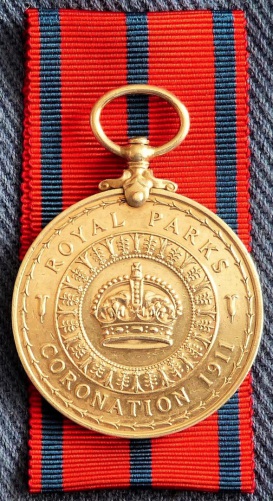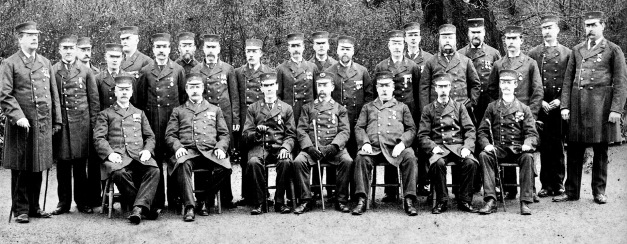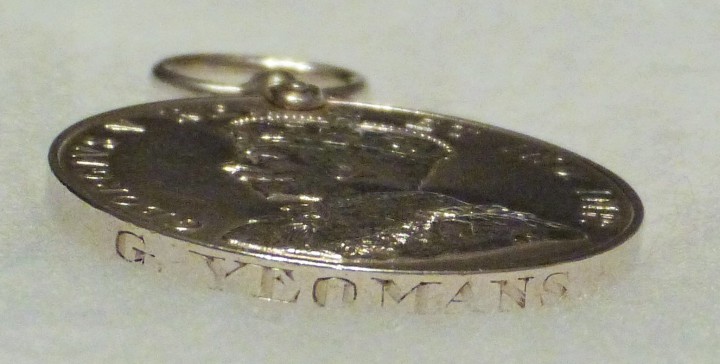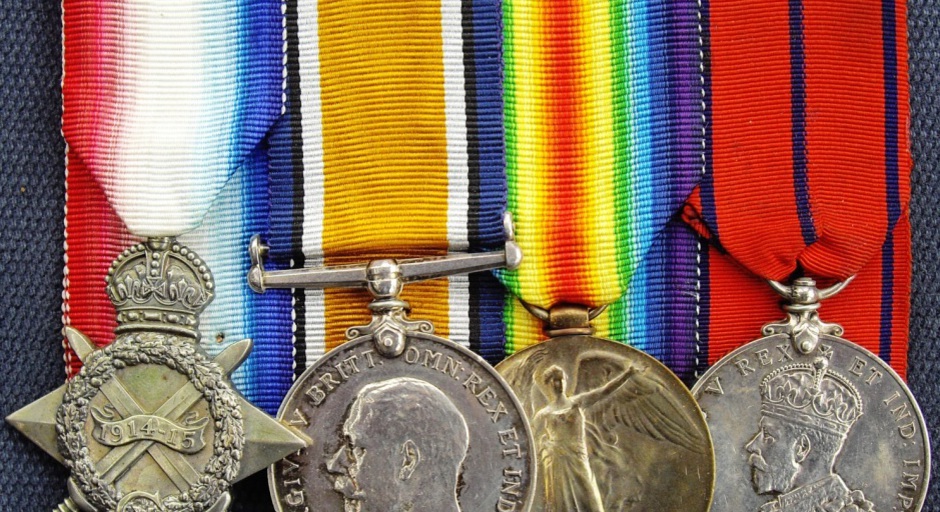
The King George V Coronation (Police) Medal, 1911
The Coronation (Police) Medal issued to commemorate the Coronation of His Majesty, King George V in 1911 was issued in ten different types of reverse. The obverse of the medal was the same in all cases.
|
Type of Medal Reverse
|
Number issued |
|
Metropolitan Police |
19,783* |
|
City of London Police |
1,400* |
|
County and Borough Police (England & Wales) |
2,565* |
|
Police Ambulance Service |
130** |
|
London Fire Brigade |
1,374* |
|
Royal Irish Constabulary |
572**** |
|
Scottish Police |
1,464*** |
|
St John Ambulance Brigade |
2,755** |
|
St Andrew’s Ambulance Corps |
310** |
|
Royal Parks |
109* |
* According to figures taken from Medal Yearbook, 2012, Page 280, Token Publishing Ltd, Honiton, Devon, the total issued to Royal Parks was 119.
The actual numbers issued were 109 to the Royal Parks in England and 11 to the Royal Parks staff at Holyrood Park in Edinburgh, making a total of 120. These figures are confirmed in Royal Parks documents held by The National Archives at Kew (WORKS 21/29/28).
** The combined total for all three ambulance services was 3,195. This figure for England confirmed from Royal Mint documents (MINT 20/458) dated 16 May, 1912. The Scottish figure is confirmed from Royal Mint documents elsewhere on this site.
The breakdown of medals issued to the various Ambulance Services is:
|
Reverse of Medal |
Police Force |
Numbers Requested |
|
St John Ambulance Brigade |
Metropolitan Police District |
2,622 |
|
St John Ambulance Brigade |
City Police District |
133 |
|
Police Ambulance Service |
Metropolitan Police District |
94 |
|
Police Ambulance Service |
City Police District |
36 |
|
St Andrews Ambulance Corps |
|
310 |
|
Total |
|
3,195 |
The 130 people in The Metropolitan Police and City Police Districts who received the medal with the Police Ambulance Reserve were in the following categories:
|
Police Ambulance Service |
|
|
Divisional Surgeons |
63 |
|
British Red Cross Society |
36 |
|
Nursing Sisters |
15 |
|
Superintendents & Drivers |
16 |
|
Total |
130+ |
+ Figures taken from Royal Mint documents at The National Archives at Kew, (MINT 20/458).
*** The figure of 2,800 quoted for the Scottish Police in Medal Yearbook is inaccurate.
The actual invoices for the total of 1,465 medals (one required re-engraving) paid by the Scotland Office in 1912 can be seen by clicking here.
****Figure taken from Peter McGoldrick's research published in the Journal of the Orders and Medals Research Society, March, 2016, Volume 55, Number 1, (310), Page 12.
Examples of each of the medal types can be seen below, the nine named medals with details of their recipients. The Royal Irish Constabulary example is un-named as issued.
London Fire Brigade
King George V Coronation (London Fire Brigade) Medal. 1911
Fireman William Peter Delamare
William Peter Delamare was born in Hoxton, London on 20 October, 1884.
He joined the Royal Navy just after his 16th birthday and served until May, 1908.
When he married Beatrice Maud Lucy Headon at the Parish Church of St John at Hackney on 5 June, 1909, his occupation was ‘Fireman'.
By the Census of 1911, William Delamare and Beatrice were living at 56 Church Hill Road, Homerton, with their 1 year old son, William.
In 1918, they were living at the Fire Station on West Ferry Road in Poplar, London.
I believe that William Peter Delamare died aged 82 in Worthing in Sussex in 1967.
Metropolitan Police
King George V Coronation (Metropolitan Police) Medal, 1911
PC Clarence William George Lanston
Clarence William George Lanston was born in Islington, London between July, August and September, 1887. His father, George Lanston, was a Postman with the General Post Office and his mother was Anne.
In the Census of 1891, the family were living at 58 Devonshire Road, Islington.
By 1901, the family were living at 14 Melford Road, Islington.
On 8 November, 1909, Clarence William George Lanston was appointed to the Metropolitan Police. His Warrant Number was 97471 and he was posted to Paddington (F) Division.
On September 28, 1912, at Christ Church, Highbury in the Parish of Islington, Clarence William George Lanston,(25), Police Officer, married Kate Martha Cheshire,(28), Spinster.
He retired on Pension on 12 November 1934 when he was serving as a Clerk Sergeant in the Commissioners’ Office (CO).
I believe he also served as a Reserve Officer in the Second World War and is probably entitled to the Defence Medal.
Clarence Lanston died on 3 April, 1946 at 8 Ecclesbourne Close, Palmers Green in Middlesex.
County and Borough Police
King George V Coronation (County and Borough Police) Medal, 1911
Manchester City Police
PC 51 B John Pearson
John Pearson was born in Beaumont in the County of Cumberland, probably in August, 1867. He was certainly baptised there on 18 August, 1867. His parents were George and Charlotte Pearson.
In the Census of 1871, the family were living in Carlisle but by 1881, they were living at 31 Tilt Street in Manchester.
According to the Appointment Ledgers held by Greater Manchester Police Museum, John Pearson joined Manchester City Police on 6 April, 1887 as PC 51 B.
He was "21", "5 feet, 8 and half inches tall", with "light brown hair", "fresh complexion" and "grey eyes". His former occupation was a "Cleaner" with the "Lancashire & Yorkshire Railway".
On 8 March, 1890, at the Parish Church in the Parish of St Augustine in Newton Heath in Manchester, John Pearson, (23), a Policeman, married Elizabeth Rylands, (21), a Bobbin Turner.
In the Census of 1891, he and Elizabeth were living at 102 Pearson Street in Manchester.
By 1901, they were still at 102 Pearson Street but by now, had four children, three girls and one boy.
In 1911, still at 102 Pearson Street, the family now had an extra girl.
The Police Review and Parade Gossip of 2 August, 1912, on page 368, reported that Coronation Medals had been presented to members of provincial police forces. Among the list of Manchester Police officers awarded the Coronation Medal the year before was PC J. Pearson.
Given his length of service, it is possible that he was awarded the medal for "Long and meritorious service".
On 19 October, 1913, he retired on pension from Manchester City Police.
I believe John Pearson died aged 68 in North Manchester in 1935.
I am indebted to the staff of Greater Manchester Police Museum for their assistance in researching John Pearson's service details and description. You can visit the Greater Manchester Police Museum by clicking here.
Scottish Police
King George V Coronation (Scottish Police) Medal, 1911
Greenock Burgh Police
DS Joseph Paterson
Joseph Grant, also known as Paterson, was born in Forres in the County of Elgin on 11 June, 1863. His mother was Marjory Grant and his father, Joseph Paterson.
In February, 1887 he was a Railway Pointsman working for the Dundee and Arbroath Joint Railway of 65 Commercial Street, Dundee and living at 12 North Erskine Street, Dundee with his uncle, Alexander Grant.
On 7 February, 1887, Joseph Paterson joined Greenock Burgh Police as a Constable.
In the Census of 1891, he was living at a Section House in the Police Station at Dalrymple Street, Greenock in Renfrewshire. There were 14 other Constables and 1 Sergeant in residence there that night.
By the Census of 1901, Joseph was a Police Sergeant, (36) and living as a Boarder at 18 Mearns Street, Greenock.
On 21 August, 1909, at Mid Anagach in Cromdale in the County of Elgin, Joseph Paterson, (46), a Detective, married Margaret Grant, (34), a Saleswoman.
Alistair Grant Paterson was born at Mid Anagach, Cromdale on 30 May, 1910. His father was Joseph Paterson, a Detective Sergeant and his mother, Margaret Grant or Paterson. The family’s usual address was 20 Murdieston Street, Greenock.
The family were still at Murdieston Street in the 1911 Census.
According to Page 368 of the August 2nd, 1912 edition of the Police Review and Parade Gossip, Detective Sergeant Joseph Paterson was one of only five officers in Greenock Burgh Police to be awarded the 1911 Coronation Medal.
Joseph Paterson retired from Greenock Burgh Police as a Detective Sergeant on 1 October, 1921 and moved back to Grantown-on-Spey.
Alistair Grant Paterson, (22), died on 28 October, 1932 at Mid Anagach, Cromdale.
Joseph Paterson, (79), died on 11 December, 1942 at Homefield, Heathfield Road in Grantown-on-Spey in the County of Moray.
His wife, Margaret Paterson, (83), died on 31 December, 1938 in the Ian Charles Cottage Hospital, Grantown-on-Spey, her usual address being Homefield, Heathfield Road in Grantown-on-Spey.
The cutting below from the Police Review & Parade Gossip of 11 November, 1921 gives a resume of Detective Sergeant Paterson's career in Greenock Burgh Police.
City of London Police
King George V Coronation (City of London Police) Medal, 1911
City of London Police
British War Medal
Victory Medal
King George V Coronation (City of London Police) Medal, 1911
PC Alfred James Nicholls
Introduction
Alfred James Nicholls was born on 31 July 1890, in Whitechapel in London. His father was Alfred James Nicholls, an Inspector in the City of London Police and his mother, Ellen Nicholls.
Census of England & Wales 1891
In the Census of the following year, his father, Inspector Alfred James Nicholls of the City of London Police and his wife, Ellen, were living in Clapham.
|
Name & Age |
Occupation |
Place & County of Birth |
|
Alfred J Nicholls, (31) |
Inspector of Police |
Richmond, Surrey |
|
Ellen Nicholls, (30) |
Wife |
Portsmouth, Hampshire |
|
Charles Nicholls, (8) |
Scholar |
London City |
|
Mary A Nicholls, (4) |
|
Whitechapel, London City |
|
Alfred J Nicholls, (8 months) |
|
Whitechapel, London City |
|
Sarah Berson, (42) |
Lodger |
Norfolk |
|
William J Berson, (14)
|
Lodger, Baker’s assistant |
Clapham, Surrey |
Register of Baptisms Holy Trinity Clapham, London
The Register of Baptisms for 1892 at the Holy Trinity Church in Clapham shows that Alfred James Nicholls, born 31 July 1890, the son of Police Inspector Alfred James Nicholls and Ellen Nicholls, was baptised there on 10 January 1892.
Census of England & Wales 1901
By 1901, the family were living in 27 Upton Park Road, West Ham, London and Alfred James (junior) was 10.
|
Name & Age |
Occupation |
Place & County of Birth |
|
Alfred J Nicholls, (40) |
Inspector of Police |
Richmond, Surrey |
|
Ellen Nicholls, (40) |
Wife |
Portsmouth, Hampshire |
|
Charles Nicholls, (18) |
Invoice Clerk |
London City |
|
Mary Ann Nicholls, (14) |
Scholar |
Whitechapel, London City |
|
Alfred James Nicholls, (10) |
Scholar |
Whitechapel, London City |
|
John Nicholls, (9) |
Scholar |
Clapham, Surrey |
|
Ellen Louisa Nicholls, (7) |
Scholar |
Forrest Gate, Essex |
|
William George Nicholls, (4) |
|
Forrest Gate, Essex |
|
Frederick Nicholls, (4 months) |
|
Forrest Gate, Essex |
City of London Police Records
Census of England & Wales 1911
By the Census of 1911, Alfred James (junior) was now 20 and a Police Constable in the City of London Police living at the Police Station, Moor Lane, London along with 60 other police officers.
The same Census shows his father as a Superintendent in the City of London Police.
Royal Naval Air Service (RNAS) and Royal Air Force (RAF) 1915 – 1920
Alfred John Nicholls, born 31 July 1890 and a Police Constable born in Bishopsgate, London, enlisted in the Royal Navy as Service No. F4672 for the ‘duration of hostilities’. His first posting was to HMS President II, possibly at Chatham in Kent. There is also another service number which could be RNAS, PI 42032.
Alfred was described as being 6’ 1.5” tall, with brown hair, brown eyes and a fresh complexion.
|
Ship Served In
|
From |
To |
|
HMS President II |
11 May 1915 |
31 January 1915 |
|
HMS Hector * |
1 January 1916 |
20 April 1916 |
|
HMS President II |
21 April 1916 |
24 May 1916 |
|
HMS President II. Promoted to Petty Officer (M) |
1 August 1916 |
5 March 1917 His Promotions are listed as: Air Mechanic 11 May 1915. Leading Mechanic 1 August 1915. Petty Officer Mechanic 1 August 1916.
|
|
(Unknown ship) Felixstowe |
6 March 1917 |
18 February 1918 |
|
No. 3 Kite Balloon Section aboard HMS Canning (RNAS) |
19 February 1918 |
31 March 1918 |
|
Re-classified as Warrant Officer Class II |
26 March 1918 |
|
|
Ship Served In
|
Effective Date |
Remarks |
|
Transferred to RAF on its formation on 1 April 1918. |
1 April 1918 |
Service Number changed to 204672 with effect from this date. |
|
HMS Canning |
12 October 1918 |
|
|
25 Balloon Base |
12 July 1919 |
2nd Lieutenant, Technical Stores. (London Gazette 12.7.19) |
|
HMS Canning, Gosport * |
18 December 1919 |
RAF Station, Gosport (see below). |
|
Gosport Station |
16 February 1920 |
Pilot Officer in charge of RAF Stores in HMS Canning , Portsmouth Dockyard. |
|
Gosport |
31 March 1920 |
Discharged. (London Gazette 16 April 1920). |
*Hector was built by Workman, Clark & Co. in Belfast and launched on 27 November 1894. She was requisitioned into service with the Royal Fleet Auxiliary (RFA) on 12 May 1915 and renamed HMS Hector in the Dardanelles. On 26 June 1915 sailed for test flight after conversion to Balloon Kite deployment.
It is likely that Alfred served in the Mediterranean aboard HMS Hector.
*The converted cargo ship HMS Canning with her observation balloon in 1918. D&W Henderson of Glasgow built the ship in 1896 for Lamport & Holt Line. She was a transport ship in the Second Boer War 1899–1900. The Admiralty bought her in 1915 and commissioned her as a Balloon Kite ship. In 1917 she became a depot ship at Scapa Flow and in 1919 she was returned to Lamport & Holt.
Among the remarks on his RAF Personnel File are the words “Service considered for the Grant of War Medals” are prominently stamped on the top right.
Under ‘Honours & Rewards’ it is recorded that he was awarded the Police Coronation Medal (1911).
Under ‘Occupation in Civil Life’ it is stated that he was a Police Officer in the City of London Police between April 1910 and May 1915.
His next of kin was listed as, ‘Alfred Nicholls, Westwood House, 28 Harrogate Road, Caversham, Reading’, relationship, ‘father’.
Register of England & Wales 1939
The register of England and Wales for 1939 records that ‘Alfred J Nichols, born 31 July 1890, a Retired City of London Police Inspector’ was living at ‘4 The Hamilton, Teignmouth, Devon’ with his wife, ‘Mable B Nicholls, born 7 May 1898’.
Register of Deaths in the District of Hastings in the County of East Sussex 1977
Alfred James Nicholls, (86), born 31 July 1890, died in the first quarter of 1977 in the Registration District of Hastings in the County of East Sussex. The entry can be found in Volume 18, page 1037 for that year.
St Andrew's Ambulance Corps
King George V Coronation (St Andrew’s Ambulance Corps) Medal, 1911
Dr Kenmure Duncan Melville
Kenmure Duncan Melville was born on 16 August, 1875 in Deesa, Bombay in India. His father, William Babington Melville was an Assistant Superintendent of the Government Telegraph and his mother was Percy Shauvel Cameron Grant or Melville. He was baptised on 16 September, 1875 by the Reverend J. Henry Blunt at Deesa in the Archdeaconry of Bombay.
In the Census of 1891, Kenmure Melville was living with his Grandmother, Georgina Grant and his mother, Percy Melville at Gilmour Road in Newington, Edinburgh.
A record exists at the British Library showing that K.D. Melville was nominated for a King’s India Cadetship at Sandhurst but I have no evidence that he attended there.
By the Census of 1901, Kenmure Melville was a Doctor working as an ‘Assistant House Physician’ at St George’s Hospital in Birmingham.
In 1911, he was back in Edinburgh living at Nile Grove with his mother, his brother Edward, a Captain in the Indian Army and their Servant, Margaret Ramsay.
He was awarded the King George V (St Andrew’s Ambulance Corps) Medal, 1911 for his work during King George V and Queen Mary's Visit to Edinburgh that year during which he was the Doctor on duty with the St Andrew's Ambulance Section at a Dressing Station at Albert Gate in King's Park, Holyrood.
The Medical Register for 1913 records that Kenmure Duncan Melville of 2 Nile Grove, Edinburgh had been first registered on 20 October, 1900 and his qualifications were Bachelor of Medicine, Bachelor of Surgery, (1900), Doctor of Medicine, (1904), University of Edinburgh.
'The Scotsman' newspaper of 10 May, 1915, carried a report of a 'Railway Ambulance Competition at Leith'. Among the examiners was 'Dr. Kenmure Melville of Edinburgh'.
Under the Medical Recruiting Scheme of 1916, he applied to become a Lieutenant in the Royal Army Medical Corps under Scheme Group A (under 45). His application is dated 22 February, 1916.
The Supplement to the London Gazette of 14 August, 1916, lists under “To be appointed temporary Lieutenants Kenmure Duncan Melville MD from 24 July, 1916”.
The 'Record of War Service' of 1914 -1919'of Edinburgh University records the following:
"Melville, Kenmure Duncan, George Watson's College and Blairlodge, Cadet Corps 1890-3, M.B., Ch.B., 1900, M.D., 1904, Q.R.v.B., Royal Scots, 1896-9, Private, R.A.M.C., Lieut. July, 1916; Captain, July,1917, 42nd and 49th General Hospitals, Salonika; 62nd General Hospital, Italy. (Mentioned in) Dispatches, June, 1919. Italian Asiago Plateau Medal, July, 1919."
(The Italian Asiago Plateau Medal:
The medal is not official but was created by the Italian authorities on the initiative of General Montuori, commander of the Italian 6th Army, and awarded early in 1919 to Italian, British and French officers of the forces that had fought in the Battle of the Piave, 15 to 24 June 1918.
The Battle of the Piave was the final throw of the Austro-Hungarian forces occupying part of north-eastern Italy when fifty-seven divisions attempted to take Allied positions and cross the River Piave. They were faced by fifty-eight Italian Divisions buttressed by three British and two French Divisions.
The Italians had advance intelligence and bombarded the massed Austro-Hungarian troops in their start trenches before they could advance. It then rained heavily making the river treacherous.
The British 23rd (Northern) and 48th (South Midland) Division defended the Asiago Plateau, suffering over three thousand casualties and gaining two Victoria Crosses. In all, Allied casualties exceeded eighty thousand men but Austro-Hungarian losses were larger still and they were never again able to mount a major offensive. The medal was issued only to officers.)
A record exists showing that a “Melville K.D., (43)” arrived at Plymouth, Devonport on Her Majesty’s Australian Troopship (HMAT) Suffolk from Sydney, Australia on 16 August, 1917.
According to the British Consular Marriages Records, on 1 June, 1918, Kenmure Duncan Melville married Martha Jane Griffin in Bordighera in Italy.
So far, I can find no Army record of Lieutenant Kenmure Duncan Melville in The National Archives or any other archive. I can find no Medal Index Card in his name but he was certainly entitled to at least the British War Medal and Victory Medal along with his 'MID' clasp from 1919.
He is also recorded on the Roll of Honour of those members of Mortonhall Golf Club in Edinburgh who served between 1914 - 1919.
When his daughter, Jean Percy Babington Melville was born on 30 November, 1919, his occupation was “Medical Practitioner” and he signed the Register of Births in Morningside in Edinburgh.
His son, Kenmure Edward Maitland Melville was born in Edinburgh on 11 November, 1923.
Kenmure Duncan Melville died aged 65 at 2 Church Hill, Edinburgh on 11 August, 1941.Martha Jane Melville registered her husband’s death.
The Scotsman newspaper of 12 August, 1941 recorded on page 3:
|
“The death occurred at his residence, 2 Church Hill, Edinburgh of Dr Kenmure Duncan Melville. He graduated M.B. Ch.B. at the University of Edinburgh in 1900 and received an M.D. Degree in 1904.
A Fellow of the Obstetrical Society, Edinburgh, he held an appointment as a house physician in the Royal Maternity and Simpson Memorial Hospital, Edinburgh and was formerly a house surgeon and house physician in the General Hospital, Birmingham.”
|
I have been unable to find any other record of Martha Jane Griffin or Melville after 1955 when she was still on the Electoral Roll in Church Hill, Morningside.
Police Ambulance Service
King George V Coronation (Police Ambulance Service) Medal, 1911
Metropolitan Police
Dr William Hele Payne (Divisional Surgeon "S" (Hampstead) Division)
The early years
William Hele Payne was born Plymouth, Devon in early, 1846. His father was John Webber Payne, a Solicitor and his mother, Caroline Elizabeth Dyer or Payne. His parents had been married in Devon in early, 1844. He was the eldest of five children, three boys and two girls.
He was baptised on 20 August, 1847 in the Parish of Folkestone in Kent.
The Census of England, 1851
In the Census of 1851, the family were living at ‘Mount Pleasant’ in Exbourne in Devon. The occupants of the house that night are listed below:
|
Name & Age |
Occupation |
Place & County of Birth
|
|
John W. Payne, (33) |
Solicitor |
Devonshire, Tavistock |
|
Caroline E. Payne, (30) |
|
Devonshire, Plymouth |
|
William H. Payne, (5) |
|
Kent, Folkestone* |
|
Mary G. Payne, (3) |
|
Kent, Folkestone |
|
John W. Payne, (1) |
|
Kent, Folkestone |
|
Rebecca Mills, (21) |
House Servant |
Devonshire, Exbourne |
* The written record on this Census states “Kent, Folkestone” as W.H. Payne’s place of birth but every other document I have found records the correct place of birth as “Devonshire, Plymouth”.
The Census of England, 1861
By the Census of 1861, the family were living at 9 Paul Street in the St Paul’s District of Bristol, Gloucestershire.
|
Name & Age |
Occupation |
Place & County of Birth
|
|
John W. Payne, (43) |
Solicitor |
Devonshire, Tavistock |
|
Caroline E. Payne, (40) |
|
Devonshire, Plymouth |
|
William H. Payne, (15) |
Scholar |
Devonshire, Plymouth |
|
Mary G. Payne, (13) |
Scholar |
Kent, Folkestone |
|
John W. Payne, (11) |
Scholar |
Kent, Folkestone |
|
Elford G. Payne, (3) |
|
Devon, Exbourne |
|
Mary G. Payne, (67) |
Landed Proprietor |
Devon, Tavistock |
|
Whitefield H. Payne, (29) |
Landed Proprietor |
Devon, Tavistock |
|
Amelia Bryant, (33) |
General Servant |
Wiltshire, Bradford |
Mary Garland Payne, (67) is John Webber Payne’s mother and Whitefield Hele Payne, (29) is his brother, therefore, they are William Hele Payne’s Grandmother and Uncle.
The Census of England, 1871
So far, I have found no trace of William Hele Payne in the Census of England in 1871.
The Medical Register of the United Kingdom, 1871
The next document I found was ‘The Medical Register (of the United Kingdom), 1871’ which records the following:
|
Date of Registration |
Name |
Residence |
Qualification |
|
1868, Aug 11 |
PAYNE, William Hele |
9 Franklin Terrace, Ashley Road, Bristol |
Mem. R. Coll. Surg. Eng. 1868 |
This confirms that William Hele Payne was registered as a Member of the Royal College of Surgeons, England on 11 August, 1868.
The Census of England, 1881
In the Census of England, 1881 William Hele Payne was living at 54 Queens Road, Peckham in London. Those living in the household were as follows:
|
Name & Age |
Occupation |
Place & County of Birth
|
|
Wm. Hele Payne, (34) |
Surgeon, General Practitioner, Member Royal College of Surgeons of England |
Devon, Plymouth |
|
Silora Elderkin, (42) |
General Servant, (Domestic) |
Huntingdonshire |
|
William John Stevens, (14) |
Page Boy Servant, (Domestic) |
Middlesex, Poplar |
The Census of England, 1891
On the night of the Census of England in 1891, William Hele Payne was a visitor to 170 Albion Road, Stoke Newington in Hackney, London.
|
Name & Age |
Occupation |
Place & County of Birth
|
|
Isabel Spencer, (41) |
|
Buckinghamshire, Wendover |
|
Edith Spencer, (12) |
|
London, Stoke Newington |
|
Cecil Spencer, (8) |
Scholar |
London, Stoke Newington |
|
Reginald Spencer, (4) |
Scholar |
London, Stoke Newington |
|
Sarah Willi, (28) |
Domestic Servant |
Berkshire, Reading |
|
Laura Harson, (22) |
Domestic Servant |
Norfolk |
|
Ellen Stellins, (18) |
Domestic Servant |
London, Stoke Newington |
|
Wm. Hele Payne, (44) |
(Visitor), Surgeon |
Devon, Plymouth |
Metropolitan Police Appointment of Divisional Surgeons, 1895 (MEPO 2/2509)
The records of the Metropolitan Police confirm that William Hele Payne was appointed to the List of Divisional Surgeons on 1 January, 1895.
The Electoral Register of Camden, London, 1897
The Electoral Roll of Hampstead in the Borough of Camden, London in 1897 records that “William Hele Payne”, was living in “Three rooms ground floor, furnished” at 9 Gayton Road, Hampstead.”
The Census of England, 1901
In the Census of England, 1901, William Hele Payne, (54), was living as a “Lodger” at 9 Gayton Road, Hampstead.”
Metropolitan Police Orders, 1903 (MEPO 7/65)
Metropolitan Police Orders (Pages 236-240) of Thursday, 26 March, 1903 records the list of those individuals then appointed as Divisional Surgeons for the Force. There are 180 names on the list and among them is:
|
Division |
Name of Divisional Surgeon |
Address |
Stations to which the Police under the Medical charge of each Surgeon are attached |
|
S |
W. H. Payne, Esq. |
23 Gayton Road, Hampstead |
Hampstead |
Metropolitan Police Orders, 1909 (MEPO 7/71)
Metropolitan Police Orders (Pages 1-6) of Friday, 1 January, 1909 records the list of those individuals then appointed as Divisional Surgeons for the Force. There are 156 names on the list and among theme is:
|
Division |
Name of Divisional Surgeon |
Address |
Stations to which the police under the Medical charge of each Surgeon are attached |
|
S |
W. H. Payne, Esq. |
23 Gayton Road, Hampstead, N.W. |
Hampstead |
The Medical Register of the United Kingdom, 1911
The Medical Register, 1911 of the United Kingdom records the following:
|
Date of Registration |
Name |
Residence |
Qualification |
|
1868, Aug 11 |
PAYNE, William Hele |
23 Gayton Road, Hampstead, London N.W. |
Mem. R. Coll. Surg. Eng. 1868 |
The Electoral Register of Camden, London, 1911
The Electoral Roll of Hampstead in the Borough of Camden, London in 1911 records that “William Hele Payne”, living in “Three rooms, two on ground floor and one on first, furnished” at 23 Gayton Road, Hampstead.”
The Census of England, 1911
In the Census of England, 1911, ‘William Hele Payne’, (‘63’), was living as a “Lodger” at 23 Gayton Road, Hampstead, N.W.”
The King George V Coronation (Police Ambulance Service) Medal, 1911
Dr William Hele Payne was one of 94 people in the Metropolitan Police District to be awarded the King George V Coronation (Police Ambulance Service) Medal, 1911.
Royal Mint documents (MINT 20/458) dated 16 May, 1912 confirm the numbers in each category of persons to be awarded the 1911 Coronation Police medal as shown below.
|
Reverse of Medal |
Police Force |
Numbers Requested |
|
St John Ambulance Brigade |
Metropolitan Police District |
2,622 |
|
St John Ambulance Brigade |
City Police District |
133 |
|
Police Ambulance Service |
Metropolitan Police District |
94 |
|
Police Ambulance Service |
City Police District |
36 |
|
Total |
|
2,885 |
The 130 people in The Metropolitan Police and City Police Districts who received the medal with the Police Ambulance Service reverse were in the following categories:
|
Police Ambulance Service |
|
|
Divisional Surgeons |
63 |
|
British Red Cross Society |
36 |
|
Nursing Sisters |
15 |
|
Superintendents & Drivers |
16 |
|
Total |
130* |
* Figures taken from Royal Mint documents at The National Archives at Kew, (MINT 20/458).
Dr William Hele Payne was still serving as a Metropolitan Police Divisional Surgeon in 1918. A letter from him (see below) to Sir Charles Ballance, Chief Surgeon to the Metropolitan Police (MEPO 2/2509) dated 20 December, 1918 confirms this.
Metropolitan Police Review of Age & Length of Service of Divisional Surgeons, 1918
In 1918, the Commissioner of the Police of the Metropolis was concerned at the age and length of service of some Divisional Surgeons in the Metropolitan Police. He directed Sir Charles Ballance to carry out a survey to determine the age and length of service of all serving Divisional Surgeons.
Sir Charles wrote to all of the Divisional Surgeons simply asking for their age and length of service. The letter provoked a great deal of reaction from the Divisional Surgeons and many wrote letters of complaint to the Chief Surgeon. Among them was a letter from Dr Fowler of Cotford House, Thornton Heath, a transcription of which is shown below:
|
“Telephone Cotford House 1398 Croydon Thornton Heath
19th December, 1918
Dear Sir Charles
Do you not think that to ask Professional Men to send you their age without assigning the slightest reason is rather an arbitrary proceeding?
Should the Commissioner hold that Doctors over a certain age are not up to their work, surely you your-self would hardly agree to age being made the test of efficiency.
Several Divisional Surgeons have communicated with me since receiving this latest mandate from the Yard and all agree that if some explanation had been given it would have been more courteous to say the least of it, is it too late for you to do this now?
Yours faithfully, (Signed) A.W. Fowler
Sir Charles Balance, K.C.M.G., M.V.O. New Scotland Yard S.W.1”
|
The results of Sir Charles Ballance survey were as shown in an appended minute from MEPO 2/2509: transcribed below:
|
“The ages of all the Divisional Surgeons are in the attached list, excluding Drs. Fowler and McIntyre, and four who are on active service.
47 Divisional Surgeons are between 40 and 50 years of age 80 “ “ “ “ 50 “ 60 “ “ “ 23 “ “ “ “ 60 “ 70 “ “ “ 4 “ “ “ “ 70 “ 80 “ “ “ 3 “ “ “ “ 80 “ 90 “ “ “
It would not be possible to replace the older Divisional Surgeons at the present time, as most young medical men are still away with the Navy or Army.
A few letters from Divisional Surgeons submitted herewith. (Signed) C. A. Balance Chief Surgeon 13.1.19”
|
The Commissioner was concerned that 30 Divisional Surgeons were between the ages of 60 and 90 and directed that letters be sent to those men over 70 years of age requesting that they resign the post of Divisional Surgeon. An example of the request letter is transcribed below:
|
“C O P Y 25th January, 1919
Dear Dr._________________
The Commissioner considers that any Divisional Surgeon over the age of 70, should send in his resignation from the post of Divisional Surgeon. I am therefore, instructed to ask you to send in your resignation.
I have great pleasure in conveying to you the sincere thanks and high appreciation of the Commissioner for your long and admirable service to the Police.
Yours very truly, (Signed) C.A. Balance Chief Surgeon”
|
In a memorandum from Sir Charles Balance to the Commissioner, also dated 25th January, 1919, he lists the 7 Divisional Surgeons over the age of 70 years. They are:
|
LISTOF DIVISIONAL SURGEONS OVER 70 YEARS OF AGE |
|||
|
Name |
Age |
Date of Appointment |
Number of years of Service |
|
Dr. James R. Haynes |
75 |
1st January, 1890 |
29 |
|
Dr. F.W. Spurgin |
81 |
24th October, 1872 |
46 |
|
Dr. George P. Bate |
75 |
7th September, 1893 |
25 |
|
Dr. Robert Esler |
82 |
1st July, 1889 |
29 |
|
Dr. W. H. Payne |
71 |
1st January, 1895 |
24 |
|
Dr. Frederick Earle |
80 |
23rd February, 1894 |
24 |
|
Dr. George Fletcher |
70 |
1st February, 1891 |
27 |
In a letter of 20th December, 1918 to Sir Charles Ballance, Dr. William Hele Payne confirmed that his age and service. A transcription of the letter from MEPO 2/2509 is shown below.
|
“Confidential
28, DOWNSHIRE HILL HAMPSTEAD N.W. 3
Re “Communication as to age”
Dear Mr Balance
My age is 71and I have been in the profession past 50 years. I am now entering upon my 25th year as Divisional Surgeon and before my appointment I had performed the duties of ‘Acting’ Divisional Surgeon for a very considerable time. My connection with the Force is therefore a long one.
I am yours sincerely,
W Hele Payne
Divisional Surgeon
To: The Chief Surgeon Hampstead (S Div.)
|
I have found no other record in the MEPO 2 files to indicate whether or not Dr. William Hele Payne resigned his appointment as Divisional Surgeon for S (Hampstead) Division.
The Electoral Register of Camden, London, 1919
The Electoral Roll of Hampstead and Holborn in the Borough of Camden, London in 1919 records “William Hele Payne”, living at “28 Downshire Hill, Hampstead”.
The final document concerning William Hele Payne is the record of his death aged 75 in 1923.
The England & Wales National Probate Calendar (Index of Wills & Administrations), 1858-1966
The entry in the above register in 1923 under “Payne, William Hele” states:
|
“Payne, William Hele of The Charterhouse, London died 11th March, 1923. Probate London 7 April to Elizabeth Jane Nursey, Spinster…”
|
(This was a very interesting research project that involved many hours searching through the MEPO files at The National Archives in Kew.
I also have records for all William Hele Payne’s brothers and sisters as well as his Grandmother and Uncle. Please contact the website if I can assist you with any enquiries.
I also have lists of Metropolitan Police District Divisional Surgeons for 1903, 1911 and 1919. If you have any enquiries regarding the identification of 1911 Coronation Medals with the Police Ambulance Service” reverse, please contact the website.
St John Ambulance Brigade
King George V Coronation (St John Ambulance Brigade) Medal, 1911
Nursing Sister Louisa Jane Laura Grimes
Louisa Jane Laura Grimes was born between April and June, 1880 in Cheltenham in Gloucester, England. Her father was Isaac Grimes, a Carpenter and Joiner, and her mother, Rose Hannah Grimes.
In the Census of 1881, the family were living at 26 Victoria Street, Cheltenham and consisted of Isaac, (34), Rose H., (34), Blanche R., (12), Alfred W., (10), Arthur H., (9), Frederick C., (6), Francis L., (40 and Louisa J., (1).
Her mother, Rose Hannah Grimes, (43), died between January and March, 1891.
In the Census that year, only Isaac, (44), Alfred, (20), Frederick, (16), Francis, (14), Louisa, (11), George, (80 and Lionel, (1) are living at 52 St Paul Street, Cheltenham. There is also a Servant named Annie Bendale, (60), living at the address.
In the Census of 1901, Laura Grimes, (21), was living as a Boarder at 36 Graham Road in Southampton in the County of Hampshire. Her occupation was ‘Infant School Assistant’.
According to the Cheltenham Chronicle of Saturday December 25, 1909:
|
“Cheltenham Technical Schools The following are the successes at the examination held at the conclusion of the ambulance course given by Dr. J. H. Blakeney, Hon. Life member of the St John Ambulance Association (with Mr A. J. Wheeler as demonstrator), that was conducted by the St John Ambulance Association: first Aid certificates: Alice Duley, Hilda Golding, Louisa Grimes, Margaret Spencer, Jeannie Whitaker, Dorothy Wilson and Agnes Mayall. Vouchers: Kathleen Kennedy, Fanny Wheeler and Elsie Brown. Medallions: Elizabeth Reading, Florence White, Lucy Croome, Laura Saville and Ada Gilkes.”
|
By the Census of 1911, Louisa, (31), was back living with her father Isaac, (64) at 23 St Paul’s Street in Cheltenham. Her brother, Lionel Victor Grimes, (21), was also living there.
Louisa’s occupation then was ‘Assistant Mistress Infant’s School’.
In the Cheltenham Chronicle of Saturday June 29, 1912, the following information was included in an article concerning the Review of the St John Brigade at Great Windsor Park.
|
“The King and Life-Saving Review of the St John Brigade The King held a review of the St John Ambulance Brigade in Windsor Great Park on Saturday; more than 14,000 members of the Brigade – about one- half of its total strength – attended the review. Between two and three thousand of these were nurses, and many representatives of the Brigade Overseas were on parade… …About seventy members of the Cheltenham Corps of the St John Ambulance Brigade, including fourteen Sisters of the Nursing Order in the charge of the Lady Superintendent, Mrs L. M. McCraith Blakeney, with Acting Officers Mrs M. Wheeler and Miss Merrit, and accompanied by their Honorary Surgeon, Dr. J. H. Blakeney, took part in the proceedings of a memorable day…
Major Shewell, Sergeant H. W. Hill, Mrs Tombe, Mr W. Mullins Inspector of Stores, Dr. Blakeney, Dr. Hutton, and Mrs Gilkes, Honorary secretary and Miss Grimes wore the medals awarded to them for ambulance services in London on the occasion of the Coronation…”
|
Louisa Grimes featured in the Cheltenham Chronicle again on Saturday January 11, 1919:
|
“A Nurse’s Success Nursing Sister Louisa J. L. Grimes of Maniton, Naunton Lane, Cheltenham, a member of the Nursing Division of the St John Ambulance Brigade, has taken examinations in Bristol for the demonstrator’s certificate in First Aid and Home Nursing, and on each occasion she has been successful.”
|
Isaac Grimes died at 1 Park View Terrace, Naunton Park in Cheltenham on 18 November, 1927.
Louisa Jane Laura Grimes, (75), died on 1 March, 1955 at the General Hospital in Cheltenham. Her usual address was Lynnville, Shurdington Road in Cheltenham.
Royal Irish Constabulary
King George V Coronation (Royal Irish Constabulary) Medal 1911
The Royal Irish Constabulary (RIC) medals were all issued un-named and it is not possible to identify the recipient of this example.
However, the Journal of the Orders and Medals Research Society, March 2016, Volume 55, Number 1 (310) on page 12 has an excellent piece of research entitled “A roll for the Coronation (Police) Medal 1911 Awarded to the Royal Irish Constabulary” by Peter McGoldrick.
Peter McGoldrick confirms from Royal Mint records at The National Archives (TNA) [i] that only 572 were struck for the Royal Irish Constabulary.
His excellent research compares a list of 572 officers listed in a “The Royal Irish Constabulary Magazine” article written in 1912[ii] to cross-match with the names in the RIC General Register of Service[iii] and arrives at a proposed roll for the Royal Irish Constabulary recipients of the medal in 1911.
It is an excellent piece of work which I strongly recommend reading. Peter can be contacted on TheOldRIC@hotmail.com
As the Royal Irish Constabulary (RIC) medals were all issued un-named, it is not possible to identify the recipient of this example from 1911.
The 1903 Visit to Ireland Medals was named and it is possible to research those through The National Archives at Kew.
A very useful guide can be found at http://www.nationalarchives.gov.uk/help-with-your-research/research-guides/royal-irish-constabulary/constabulary/
A very interesting website by Michael James Talbot concerning his Great Uncle, James Talbot who served in the RIC from July, 1890, is well worth a look and can be found at
http://royalirishconstabulary.webs.com/
Royal Parks
King George V Coronation (Royal Parks) Medal 1911
Royal Parks
George Sutton Yeomans
The early years
George Sutton Yeomans was born in the hamlet of Forehoe in the Parish of Barnham Broom in Norfolk, probably in late 1848. He was certainly baptized in Barnham Broom Parish Church on 7 January, 1849 as it is recorded on Page 57 of the local Parish Register for that year.
His father was Ralph Yeomans, a Gardener, born in Hardingham, Norfolk around 1814 and his mother, Thirza Julia Cook Yeomans, born in 1818 in Neatishead, Norwich in Norfolk. Ralph and Thirza had been married in Norwich in 1841.The Rector of the Parish Church, the Reverend Edward Gordon performed the Baptism ceremony for George Yeomans.
You can find out more about Ralph and Thirza Yeomans at Barnham Broom by looking here: http://www.norfolkmills.co.uk/Watermills/barnham-broom.html
In the Census of England in 1851, the following were living at Hill Road, Forehoe in Barnham Broom:
|
Name (Age) |
Occupation |
Where born |
|
Ralph Yeomans, (38) |
Gardener |
Norfolk, Hardingham |
|
Thirza Julia Yeomans, (32) |
Gardener’s Wife |
Norfolk, Neatishead |
|
Thomas William Yeomans, (9) |
Scholar |
Norfolk, Barnham Broom |
|
Mahala Ann Clarissa Yeomans, (7) |
Scholar |
Norfolk, Barnham Broom |
|
Sarah Ann Harriet Yeomans, (5) |
At home |
Norfolk, Barnham Broom |
|
George Yeomans, (3) |
At home |
Norfolk, Barnham Broom |
|
Harriet Elizabeth Yeomans, (9 months) |
At home |
Norfolk, Barnham Broom |
In the Census of 1861, the family were now at Brandon Road, Barnham Broom and the following were registered at that address:
|
Name (Age) |
Occupation |
Where born |
|
Ralph Yeomans, (49) |
Jobbing Gardener |
Norfolk, Hardingham |
|
Thirza Yeomans, (42) |
|
Norfolk, Neatishead |
|
Sarah Ann H. Yeomans, (15) |
|
Norfolk, Barnham Broom |
|
George S. Yeomans, (13) |
Gardener |
Norfolk, Barnham Broom |
|
Harriet Elizabeth Yeomans, (11) |
Scholar |
Norfolk, Barnham Broom |
|
James John Yeomans, (9) |
Scholar |
Norfolk, Barnham Broom |
|
Lucy Mary Ann Yeomans, (7) |
|
Norfolk, Barnham Broom |
|
Frederick A. Yeomans, (4) |
|
Norfolk, Barnham Broom |
|
Arnard C. Yeomans, (2) |
|
Norfolk, Barnham Broom |
|
Alice M. Yeomans, (2 months) |
|
Norfolk, Barnham Broom |
In the same Census in the Channel Islands, living at the Gas Works in Alderney were Charles Hyett, (30), a Gas Fitter, his wife Ellen, (30) and their children Fanny, (5), Alfred, (4), Harry, (3) and Elizabeth, (8 months).
The 83rd (County of Dublin) Regiment of Foot
The next public record found for George Yeomans is dated at Norwich on 26 June 1867. It was on that date that George Yeomans, 19 years, 5’ 6”, fresh complexion, grey eyes with light brown hair, a native of the Parish of Barnham Broom, Norfolk and a Confectioner by trade, enlisted as Private 1808 in the 83rd Regiment of Foot for 12 years, for which he received the Bounty of £1.
His Army record records the Declaration he made at ‘The Police Court of the Guildhall, Norwich on 28 June, 1867 in the presence of Thomas Brightwell, Justice:
|
DECLARATION TO BE MADE BY RECRUIT ON ATTESTATION
“I George Yeomans now residing in the Parish of St Johns in the City of Norwich do solemnly and sincerely declare, That to the best of my Knowledge and Belief I was born in the Parish of Barnham Broom in the County of Norfolk and am 18 Years of Age; that I am of the Trade or Calling of a Confectioner; that I am not an Apprentice; that I am not married; that I am not a Widower; that I do not belong to the Militia; or to the Naval Coast Volunteers, or to any portion of Her Majesty’s Land or Sea Forces; that I have never served Her Majesty by Land or Sea in any Naval or Military employment whatsoever; that I have never been marked with the letter D*; that I have never been rejected as unfit for Her Majesty’s Service on any previous Enlistment; that I was enlisted at Norwich on 26th day of June, 1867 at 2 O’ clock pm by David Farley, Pensioner and that I have read to me the Notice then given to me and understood its Meaning; that I enlisted for a Bounty of One Pound and a Free Kit, and have no Objection to make to the manner of my enlistment; that I am willing to be Attested to serve in the 83rd Regiment of Foot for the Term of Twelve Years provided her Majesty should so long require my services, and also for such further term, not exceeding Twelve Months as shall be directed by the Commanding Officer on any Foreign Station.”
|
* (Branding tools stamped the letter ‘D’ on the skin of army or navy deserters. The adjustable points bearing ink were pushed through the skin by a sprung-powered mechanism.
This device was made by Savigny & Co, better known as a major London maker of surgical instruments in the 1700s and early 1800s. Branding as a form of punishment and a mark of ownership exists throughout history. Branding was abolished in 1829 with the exception of army deserters. After this time, the mark was tattooed on the body.
The practice was totally abandoned in 1879.)
His Military History Sheet records his postings over the 21 years he went on to serve with the Colours as shown below.
|
Country |
From |
To |
Years Days |
|
Home |
28.6.67 |
17.10.67 |
- 110 |
|
Gibraltar |
18.10.67 |
10.3.70 |
2 146 |
|
East Indies |
11.3.70 |
14.1.81 |
10 310 |
|
Natal S. A. |
15.1.81 |
3.1.82 |
- 354 |
|
Home |
4.1.82 |
12.6.88 |
6 160 |
|
Home |
13.6.88 |
27.6.88 |
- 15 |
|
|
|
Total |
21 - |
His original next of kin was recorded as “Father, Ralph Yeomans, Barnham Broom, in Norfolk”.
The Army in Ireland & Gibraltar
The Regiment was part of the Garrison in Ireland at Newry, County Armagh until October, 1867 when it moved to Gibraltar. On 10 March, 1870, the Regiment embarked for India
The Army in India
In 1871 the Regiment was at Poona in the State of Maharashtra until 1872 when it moved to Asirgarh in the State of Madhya Pradesh. By 1873, the Regiment was a Deesa in the State of Gujarat. In January 1879, it was in ‘Kurrachee’ (Karachi) in the State of Sindh, now Pakistan. By 5 July that year, the Regiment had moved to Belgaum (now known as Belagavi) in the State of Karnataka.
The conditions were difficult in India and during the 10 years, 310 days that George Yeomans spent there, his medical records show that he was admitted to hospital on 18 occasions suffering from either ‘dysentery’, ‘hepatitis’ or ‘remittent fever’ caused by the ‘climate’.
George Yeomans seemed to be a good soldier and was promoted as shown below:
|
Rank & Dates of Promotion; also Dates of Transfer to other Regiments
|
Date of Punishment; and whether Corporal or by Imprisonment |
|
Corporal, 20 April, 1870 – 30May, 1872 |
|
|
Sergeant, 1 June, 1872 – 6 September, 1875 |
|
|
|
Reduced 11 September, 1875 for “Breaking out of Barracks” in Deesa, Gujarat in India. |
|
Corporal, 10 March, 1879 – 28 December, 1879 |
|
|
Lance Sergeant, 29 December, 1879 – 30 April, 1888 |
|
George Yeomans had spent over a month in hospital in Deesa with dysentery a few months before his punishment for “Breaking out of barracks”.
It was from Belgaum (now known as Belagavi) in the State of Karnataka that the regiment embarked on the journey to South Africa on 14 January, 1881.
South Africa, Transvaal
Lance Sergeant Yeomans served in the Transvaal Campaign of 1881 for which no medal was awarded. Shortly after this the 83rd (County of Dublin) Regiment of Foot amalgamated with the 86th (Royal County Down) Regiment of Foot to form the Royal Irish Rifles.
On 3 January, 1882, the Regiment left South Africa for ‘home’. George Yeomans Army files show that until he was discharged in 1888, he saw service in Dover (Kent), Shorncliffe (Kent), Aldershot (Hampshire), Alderney (Channel Islands), Gosport in Hampshire and Mullingar, County Westmeath, Ireland.
Home Service in Kent, Hampshire, the Channel Islands, Marriage and back to Ireland
His record also shows under ‘Medals and Decorations’ that he was “Granted Silver medal for Long Service & Good Conduct with Gratuity of £5/-/- 13 August 1885 (lined through and substituted with) 30 June, 1885”.
It is highly likely that he met his future wife while stationed in Alderney in 1884 and after his marriage to Elizabeth Ellen Hyett in Alderney on 13 December, 1885, his next of kin became his wife.
Probably when he was stationed in Portsea in Hampshire, (* see list of Barracks in Portsmouth in that year) his son George Ralph Yeomans was born in March, 1887 at Portsea Island, Hampshire.
*
|
Barracks in Portsmouth in 1885 |
Remarks |
|
Anglesea Barracks |
Portsea Town. Infantry. Replaced by Royal Naval Barracks in early 1900s. Now known as H.M.S. Nelson. |
|
Cambridge Barracks |
Old Portsmouth. Infantry. The site and buildings eventually became Portsmouth Grammar School. |
|
Clarence Barracks |
Old Portsmouth. Infantry. |
|
Colewort Barracks |
Old Portsmouth. Infantry. |
|
Eastney Barracks |
Eastney. Royal Marine Artillery. |
|
Gunwharf Barracks |
Old Portsmouth. Infantry. |
|
Hilsea Barracks |
Hilsea. Artillery. |
|
Mill Dam Barracks |
Old Portsmouth. Corps of Royal Engineers, part of Ordnance Department. The Royal Engineers continued to use the barracks until at least 1959. |
|
Point Battery Barracks |
Old Portsmouth. |
|
Tipner Barracks |
Tipner. Infantry. |
For further information on Portsmouth, please look at https://www.portsmouth.gov.uk/ext/documents-external/lib-portsmouthencyclopaedia-2011.pdf
George Yeomans was discharged from the Royal Irish Rifles as a Lance Sergeant on 27 June, 1888 at Mullingar, (built in 1814 and originally named Wellington Barracks, after 1922 renamed Columb Barracks) County Westmeath, Ireland. He was 40 years old and his conduct was “Very Good”.
To see an image of Mullingar Barracks in the early 1900s, please look at http://irishgarrisontowns.com/greetings-from-mullingar/
Life after Retirement from the Army
So far, I have been unable to find any record of George Yeomans in the Census of England in 1891. I have, however found other records that show he was living in London from at least 1888 as the following UPDATE proves.
UPDATE 17 March, 2018 - Please see birth of 1st child below:
On 28 November, 1888, at the Parish Church of St Matthew in Bayswater, London, Frederick John Yeomans was baptised. His parents were George Sutton and Elizabeth Helen Yeomans. His father's occupation was 'Park Keeper'.
His death was recorded in the 3rd Quarter of 1888 in the Paddington Registration District of London.
William Sutton Yeomans was born in Marylebone, London in 1890. Given the place of birth, it is likely that his father had already been appointed to the staff of the Royal Parks.
UPDATE 17 March, 2018 - Please see Census below:
Census of England, 1891
The following were living at 5 Bark Place, Bayswater in 1891.
|
Name (Age) |
Occupation |
Where born |
|
George Sutton Yeomans, (43) |
Park Keeper, Royal Parks |
Norfolk, Barnham Broom |
|
Elizabeth Yeomans, (30) |
Wife |
Alderney, Channel Islands |
|
George Yeomans, (4) |
Railway Junior Clerk |
Portsmouth, Hampshire |
|
William Yeomans, (1) |
|
Paddington, London |
It is clear from the above birth of Frederick John Yeomans in November, 1888 that George Yeomans was employed as a Park Keeper with Royal Parks almost imediately after leaving the Army in June, 1888.
On 8 January, 1894, “George Yeomans, 6” years old was admitted to “Fox School, Kensington and Chelsea”. His father was “George Yeomans of 5 Bark Place”. Bark Place in Notting Hill is about five minutes from Hyde Park, one of eight Royal Parks in London. UPDATE 17 March, 2018. This is now confirmed by the Census of 1891 (see above) as the family were living at 5 Bark Place, Bayswater in that year.
On 25 July, 1896, the late Thurza Julia Yeomans, was buried at Barnham Broom, Norfolk.
Ralph Yeomans, born about 1814, died in Norwich in the first quarter of 1899.
In the Census of 1901, the following were living at 5 Barrow Hill Road, London in the Parish of St Marylebone. Barrow Hill Road is about five minutes from Regent’s Park, another London Royal Park.
|
Name (Age) |
Occupation |
Where born |
|
George Sutton Yeomans, (53) |
Park Keeper, Royal Parks |
Norfolk, Barnham Broom |
|
Elizabeth Yeomans, (39) |
Wife |
Alderney, Channel Islands |
|
George Yeomans, (14) |
Railway Junior Clerk |
Portsmouth, Hampshire |
|
William Yeomans, (11) |
|
Marylebone, London |
By 1911, the family had moved round the corner to the Hanover Gate Lodge, Park Road, Regent’s Park in London N.W.
|
Name (Age) |
Occupation |
Where born |
|
George Sutton Yeomans, (63) |
Army Pensioner, Gate Keeper |
Norfolk, Barnham Broom |
|
Elizabeth Helen Yeomans, (51) |
|
Alderney, Channel Islands |
|
George Ralph Yeomans, (24) |
Railway Clerk |
Portsmouth, Hampshire |
|
William Sutton Yeomans, (21) |
Omnibus Company’s Clerk |
Marylebone, London |
The 1911 Census was controversial in that for the first time, women were compelled to record information regarding childbirth and length of their marriage. The Suffragettes organised a boycott of that section of the Census Schedule which meant that such information is not universally available.
From a purely researcher’s point of view, such information is invaluable to determine the year of marriage and the birth years of any subsequent children. In this case, the information in respect of Elizabeth Helen Yeomans recorded on the Schedule is shown below:
|
Write “Single”, “Married”, “Widower”, or “Widow” opposite the names of all persons aged 15 years and upwards.
|
State for each Married Woman entered on this Schedule, the number of:-
|
|||
|
Completed years the present Marriage has lasted. If less than one year write “under one”.
|
Children born alive to present Marriage. (If no children born alive, write “None” in Column 7.
|
|||
|
Total children Born Alive |
Children still Living |
Children who have Died |
||
|
Married
|
26 |
4 |
3 |
1 |
From the 1911 record, it is clear that throughout her marriage, Elizabeth had four children, three of whom were still alive in 1911 and two of whom, I have yet to find in the records. Given the size of the population of England, it is quite difficult to identify births not recorded in Census’ but it is probable the other two children were born between 1885 and 1905? UPDATE 17 March, 2018. See above.
On 22 December, 1912, “William Sutton Yeomans, (22), a Clerk”, married “Edith Letitia Stranks, (21), a spinster, at the Parish Church of St Marylebone in the County of London”. George Yeomans was one of the witnesses to the marriage.
On 7 December, 1915, “William Sutton Yeomans” of 144 Portnall Road, Paddington” was “Attested as a Private in the 5th Battalion the Bedfordshire Regiment at Paddington”. His next of kin was “Edith Letitia Yeomans” and “Muriel Jean Ida Yeomans” born in 1913 and “Frank Sutton Yeomans”, born in 1916 are also recorded in the Army papers.
Although attested in December, 1915, William did not join his battalion until 1 May, 1916. He never left the United Kingdom and on 20 April, 1917 was “Discharged under Paragraph 392 (XXV) King’s Regulations and Army Council Instruction 2333 of 1916”.
On 9 September, 1915, “George Ralph Yeomans, (28), a Merchant’s Clerk”, married “Audrey Ada stone, (26), a Spinster, at the Parish Church in the District Parish of St Mark, Hamilton Place in the County of London”. William Yeomans was one of the witnesses to the marriage.
The County of Surrey Electoral Register of 1918 for the Parliamentary Constituency of Epsom lists “George Sutton Yeomans” and “Elizabeth Helen Yeomans” living at “Bellgates Lodge, Ewell Road in Cheam”. To see more about this area, please click on https://historicengland.org.uk/listing/the-list/list-entry/1001672
Bellgates Lodge is on the edge of Nonsuch Park and they were still recorded living there in the Electoral Register of 1921.
The end of the story
The death of Elizabeth Helen Yeomans, born about 1860, was recorded in Croydon in September, 1926. Curiously, both George and Elizabeth are recorded in the Surrey Electoral Register living at Cheam Lodge, Nonsuch in 1927.
George Sutton Yeomans, (79), died at 45 Dovercourt Avenue, Thornton Heath in Surrey on 28 February, 1928. Probate granted on 11 June, 1928 was in favour of George Ralph Yeomans, an Accountant.
UPDATE 17 March, 2018
On 29 May, 1928, George Sutton Yeomans, (79) of the Lodge, Nonsuch Park, Surrey, was buried in the Parish Church of St Dunstan, Cheam in Surrey,
On 29 March, 1955, Edith Letitia Yeomans of 30 Munster Gardens, Palmers Green, in North London (Middlesex) died at home. In Probate dated 18 May, 1955, William Sutton Yeomans, a Fruit and Vegetable Salesman, inherited her estate.
William Sutton Yeomans, born 27 March, 1890, died in Haringey in North London in June, 1976.
In December, 1967, George R. Yeomans, (80), died in the Registration District of Lambeth in Greater London.
Audrey Ada Stone or Yeomans, born 3 November, 1889, died in March, 1973 in Croydon in Greater London.
The ‘loose ends’ to complete the story
In order to complete the story, I would like to find the one ‘missing’ children of George and Elizabeth Yeomans and to trace the Army Long Service and Good Conduct Medal awarded to George Sutton Yeomans in 1885.
Neither is beyond achievement but both will require some patience and perseverance on my part. If you are aware of the location of 1808 Lance Sergeant George Sutton Yeomans Army Long Service & Good Conduct Medal, please get in touch with me at enquiries@scottishpolicemedals.co.uk Thank you.
Additional Notes:
The actual numbers of medals issued with 'Royal Parks' reverse were 109 to the Royal Parks in England and 11 to the Royal Parks staff at Holyrood Park in Edinburgh, making a total of 120. These figures are confirmed in Royal Parks documents held by The National Archives at Kew, reference, WORKS 21/29/28.
This new section was begun in November 2014 and completed in March, 2016.
If you are able to supply further details or even pictures of any of the recipients, please get in touch with the website.
Thank you.
www.scottishpolicemedals.co.uk
